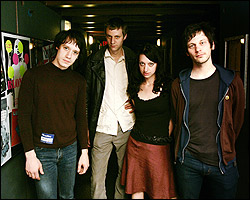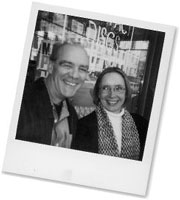Michael Pollan caught my attention and admiration, as he no doubt caught yours, with Botany of Desire: A Plant’s-Eye View of the World, but he doubled it by agreeing to be interviewed in Vice magazine’s recent food issue. Any academic can toss off a few thousand words for The New York Times, but to be willing to appear in this sex-drugs-and-rock-and-roll-themed, hypersurrealist, hyperhipster free monthly, you have to be pretty committed to taking it to the streets—and how many academics even think of taking it to the streets? (The fact that such a magazine published a food issue: a sign of the apocalypse or a sign of the revolution? Discuss amongst yourselves.) Of course, the Vice Q&A was a promo opportunity for Pollan’s newest, The Omnivore’s Dilemma: A Natural History of Four Meals;I got my hands on the magazine and the hardcover on the same Tuesday and nearly popped a blood vessel waiting for the day to end and my bus ride/reading hour to begin.
The interview, which Vice titled “Children of the Corn,” is informative, and also perfectly angled toward the twentysomethings who eat the magazine’s shock-talk right up. “But isn’t that snobby? Poor people can’t eat organic,” prompts the interviewer, Jesse Pearson, allowing Pollan to get at why cheap food is so cheap—hint: the surfeit of a certain crop—and then why so much food is so full of that same crop (or, that same crap). “Oh yeah, Coke is corn. That’s so fucked up,” says Pearson. The conversation isn’t necessarily genius, and the magazine isn’t recommended material for the average “foodie” (one very, um, Hunter S. Thompson–type feature attempts to solve that age-old question: Whose farts smell worse? Carnivores or herbivores?). Still, I think both sides of the Q&A equation are to be commended for opening up the conversation. Ironic, acerbic, indelicate urban types need to be exposed to the complexities of modern eating, too.
Those complexities, introduced in the interview, are laid flat on their back and dissected expertly by Pollan in his book. The basic question he sought to answer is, essentially, what should we have for dinner? Pollan’s premise is that we have too many choices, but too few substantive ones. Furthermore, “‘What should I eat?’ [can] no longer be answered without first addressing . . . ‘What am I eating? And where in the world did it come from?'” So Pollan divided his research, and the text, into three avenues, all of which end at our plate: industrial food, organic or alternative food, and food we kill or harvest with our own hands.
Not surprisingly, the densest chapters are those focusing on industrialized food, which the author defines as “any food whose provenance is so complex or obscure that it requires expert help to ascertain.” This would be those “chicken” nuggets you feed your kids, the Doritos you had with lunch, the soda you’re sipping, and the entire frozen food aisle. In sections like the one called “Corn Sex,” Pollan talks genetics, agribusiness, nutrition, and sourcing—and I mean, he really talks them. He tells stories about Mexican maize farmers, Midwestern corn huskers, and mad cows. He makes their stories—and more miraculously, the science behind them—highly readable.
Moving on to address such issues as “big” organic corporations, the ethics of eating animals (especially those you haven’t killed yourself), food miles, and, echoing the poet Wallace Stevens, the 13 ways of looking at a cow pasture, Pollan has created the most important book of the year. If you eat, you have to read it—or at least go hear Pollan talk when he comes to town this month and next (details below or at www.michaelpollan.com).
If you read the recent column titled “Three Perfect Things,” you might be curious about the answer to C.K.’s question: What happened to Bamboo Terrace on Interlake Avenue North? Within two days of publication, I got an e-mail from the former owner of the Terrace, who now operates Moby’s Restaurant and Lounge on the first floor of the Convention Center at Seventh and Pike. “Our cuisine has changed a bit but [we] still incorporate Asian influences into our food,” Kandie Loo reported.
Another question recently came our way: S.W.-B. is looking for the folks behind Domani Restaurant, which used to be in Bellevue. If you know the whereabouts of chef Rick Hansen or co-owner Dick Hall, let us know.
And if you’re in West Seattle and you’re looking for pizza, check this out: West 5 co-owner Dave Montour told me that a new pizzeria is moving in near the Junction, into the space formerly occupied by the Chinese joint/karaoke bar New Luck Toy. Who’s behind it? The team behind Fremont’s Triangle Tavern and the Ballroom, so if you’re looking for pizza and a date, you’re doubly in luck.







